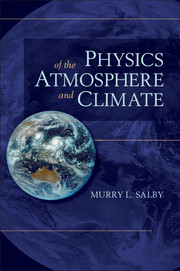Book contents
- Frontmatter
- Contents
- Preface
- Prelude
- 1 The Earth-atmosphere system
- 2 Thermodynamics of gases
- 3 The Second Law and its implications
- 4 Heterogeneous systems
- 5 Transformations of moist air
- 6 Hydrostatic equilibrium
- 7 Static stability
- 8 Radiative transfer
- 9 Aerosol and cloud
- 10 Atmospheric motion
- 11 Atmospheric equations of motion
- 12 Large-scale motion
- 13 The planetary boundary layer
- 14 Wave propagation
- 15 The general circulation
- 16 Dynamic stability
- 17 Influence of the ocean
- 18 Interaction with the stratosphere
- Appendix A Conversion to SI units
- Appendix B Thermodynamic properties of air and water
- Appendix C Physical constants
- Appendix D Vector identities
- Appendix E Curvilinear coordinates
- Appendix F Pseudo-adiabatic chart
- Appendix G Acronyms
- Answers to selected problems
- References
- Index
- Plate section
Preface
Published online by Cambridge University Press: 05 June 2012
- Frontmatter
- Contents
- Preface
- Prelude
- 1 The Earth-atmosphere system
- 2 Thermodynamics of gases
- 3 The Second Law and its implications
- 4 Heterogeneous systems
- 5 Transformations of moist air
- 6 Hydrostatic equilibrium
- 7 Static stability
- 8 Radiative transfer
- 9 Aerosol and cloud
- 10 Atmospheric motion
- 11 Atmospheric equations of motion
- 12 Large-scale motion
- 13 The planetary boundary layer
- 14 Wave propagation
- 15 The general circulation
- 16 Dynamic stability
- 17 Influence of the ocean
- 18 Interaction with the stratosphere
- Appendix A Conversion to SI units
- Appendix B Thermodynamic properties of air and water
- Appendix C Physical constants
- Appendix D Vector identities
- Appendix E Curvilinear coordinates
- Appendix F Pseudo-adiabatic chart
- Appendix G Acronyms
- Answers to selected problems
- References
- Index
- Plate section
Summary
Global measurements from space, coupled with large-scale computer models, have widened the perspective of atmospheric science along with its subdiscipline, the study of climate. Supporting those tools are proxy records of previous climate upon which rest interpretations of the current state of the Earth-atmosphere system. While opening new avenues of investigation, these modern tools have introduced increasingly complex questions. Many concern the tools themselves. Uncertainties surround the interpretation of observations, especially proxy records of previous climate, how key physical processes are represented in Global Climate Models (GCMs), and discrepancies between those models. These uncertainties make an understanding of the controlling physical processes and limitations that surround their description essential for drawing reliable insight into the Earth-atmosphere system.
Emerging simultaneously with technological advances has been growing concern over the role of humans in global climate. Buttressed by wide-ranging claims of environmental consequences, such concern has been pushed into the limelight of major national and international policy. The popular ascent of climate research has not been without criticism. Notable are concerns over rigor and critical analysis, whereby (i) proxies of previous climate, relied upon in interpretations of current climate, are often remote and ambiguous and (ii) insight into underlying physical mechanisms has been supplanted by models which, although increasingly complex, remain, in many respects, primitive and poorly understood. Despite technological advances in observing the Earth-atmosphere system and in computing power, strides in predicting its evolution reliably – on climatic time scales and with regional detail – have been limited.
- Type
- Chapter
- Information
- Physics of the Atmosphere and Climate , pp. xv - xviiiPublisher: Cambridge University PressPrint publication year: 2012

